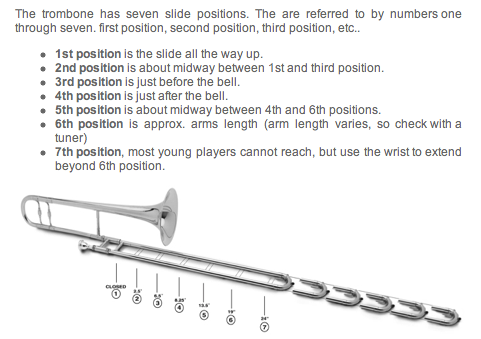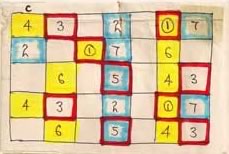
Visual Thinking for Slide Trombone (by Craig Rusbult, Ph.D.)
When playing a trombone, the pitch of a note is determined by a combination of the buzzing pitch and slide position. When the slide is pushed outward, the trombone gets longer and the note-pitch becomes lower. To produce the best possible musical tone, you want the buzzing pitch and slide position to be perfectly matched. For example, if you are buzzing an A (with frequency = 440 cycles/second) and your slide is in a “2nd position” at the exact location that gives your trombone a resonant frequency of 440 cycles/second, this “matching” will help you produce your best tone. { I say "help" because other factors also affect the tone. }
This diagram (source) shows the 7 positions, after describing them.
 |
Each slide-position corresponds to one semi-tone: moving the slide from 1st position to 2nd position lowers the pitch by one semi-tone, and so does moving from 2nd to 3rd position, and so on.
This page uses the logical principles of Music Theory — keys, scales, chords, and arpegios. If you don't already understand these principles, they are explained in my page about Musical Improvisation - Making Music by using Creativity & Music Theory.
Scales and Chord-Arpegios: When playing trombone, sometimes I visually imagine “spatial patterns” for notes and their combinations, especially for arpegios that are made by playing the 1st, 3rd, and 5th notes of a scale in some kind of sequence.
Below, the left-side diagram shows the slide positions for a C-scale; first position is in the left column (with 4,2,4), second position is in the second column, and so on, out to the 7th column (with 7,3,7,3) for 7th position. The lowest notes are in the bottom row, and highest notes are in the top row. If you "read it backwards" beginning on the bottom-right and moving lefward in each row, moving upward (this is the opposite of how we read in English) the notes increase in order, "3 4 5 6, 7 1 2 3 4, 3 4 5 6, 6 7 1 2 7 1 2 3 4". Notice that some notes (those in gray font) are duplicated, because they can be played in two different positions. (note: Trombonists with good technique can play notes higher than the top row shown here, and those using a "bass trombone" [with extra tubing that can produce the equivalent of a super-long trombone] can play notes that are one row lower than the bottom row shown here.)
The key of C-major has three main chords (C, F, and G, built on the 1st, 4th, and 5th notes of the C-scale) and the notes in each chord are shown: the three notes of a C-major chord (the 1st, 3rd, and 5th notes of the C-major scale) are outlined in red; the three notes of an F-major chord (the 1st, 3rd, and 5th notes of an F-scale, which are the 4th, 6th, and 8th/1st notes of the C-major scale) are highlighted in yellow; and the three notes of a major G-major chord (the 1st, 3rd, and 5th notes of a G-scale, which are the 5th, 7th, and 9th/2nd notes of C-scale) are outlined in blue. (note: a C-scale keeps repeating, one octave above another, so the 8th note of a C-scale is C, the same as its first note but an octave higher, which I've written as "8th/1st"; similarly, the 2nd and 9th notes are both D, separated by an octave, "9th/2nd")
 |
 |
Above, the diagram for C-major has 5 rows & 7 columns. On the right side you see 8 analogous diagrams; the top-left is for C-major (same as at left but it has been photo-reduced), and below it are three other major keys, for F major, B-flat major, and E-flat major. On the right side are the corresponding minor keys using the same 7 notes: A minor (using the same notes as C major), D minor, G minor, and C minor. / You can see large-size diagrams for all of the 12 major keys — C, F, B-flat, E-flat and E, A, D, G and A-flat, D-flat, G-flat, B — and their corresponding 12 minor keys.
The 3 Chords (each with 3 Notes) in Each Key: Below, the top half (10 rows and 84 columns, split into 24 blocks, each with 5 rows and 7 columns) shows all 24 scales: 12 major (B, E,... G-flat) in the top row of blocks, and 12 minor (G-sharp,... E-flat) in the bottom row. If you compare the C-major diagrams above and below, you'll see that they have the same scale-notes: 4 3 2 1 7 in each top row (or 7 1 2 3 4, going upward from low pitches to higher pitches) and so on down to the bottom row with 6 5 4 3. The yellow highlighting, in the upper-right corner of each block, is not for the 4-chord (as with the F-chord above); instead, this yellow area shows "alternate positions" where the same note can be played in two positions; for example, the "middle F" can be played using 1st position (in the row that is 2nd from bottom) or using 6th position (in the 3rd row from the bottom).
Notice that the 1st, 4th, and 5th notes for an F-major scale are F, B-flat, and C, which is F plus the blocks to its right and left. And for D-minor (directly underneath F major, symbolizing its use of the same notes) these notes are D, G, and A, which is D plus the blocks to its right and left. These relationships are explained verbally, and shown visually, in Part 2B of my page for Musical Improvisation.

The 3 Notes in Each Chord: Above, the bottom half (with 10 rows and 84 columns, split into 24 blocks for 12 major keys & 12 minor keys) shows the same information but in a “visually simplified” way that lets you focus on the notes within each chord. Each block shows only the notes in one chord. For example, the block for “C” shows the notes in a C-chord — the 1st notes (black), 3rd notes (green), and 5th notes (red) for a C-scale, C E G — which are the 1st, 3rd, and 5th notes of a C-scale. In the block to its right, you see the notes of an F-chord — these are the 1st, 3rd, and 5th notes of an F-scale, F A C — which (in the diagrams above for a C-scale) are the 4th, 6th, and 8th/1st notes of a C-scale. Similarly, the notes of a G-chord — the 1st, 3rd, and 5th notes of a G-scale, G B D — are the 5th, 7th, and 9th/2nd notes of a C-scale.
Sliding in the Key of F: On a slide trombone, I like playing in the key of F-major because it allows the maximum number of long “continuous sliding” between chord-notes (these slides are called glissandos) in the three major-chord arpegios, as you can see in the blocks for chords of C, F, and B-flat, which are shown by a bracket spanning these 3 blocks. These are the three main chords in the key of F Major, and all three chords have a glisssando-slide for each of their 5 rows. / note: The squares that are cross-hatched are “alternate positions” for notes, as explained above. For example, in a C-chord the lowest 3rd-note (the A of FAC) is normally played in 2nd position (solid red) but it also can be played in 7th position (cross-hatched red). These alternate positions add to the options that can be used for glissandos.
Sliding in 12-Bar Blues: I think trombone has the potential for being a very special instrument for playing blues, due to its natural ease of sliding between notes, and changing the pitch of a note so it's a bit lower or higher. It seems to me (although maybe it's just because I don't know what's already been done) that this potential hasn't been deeply explored by trombone players, in the ways it could be.
Sliding to Produce Harmonies: I was inspired to "think about possibilities" when hearing a long glissando by Urbie Green. With one or more trombones, a creative composer could invent constantly-changing harmonies (and disharmonies) in a variety of ways that are musically interesting. But so far I haven't done much to explore the possibilities. And I don't know if this has been done by others.
Directly below the 3 chords for F-major (C, F, B-flat, within the brackets) are the corresponding minor chords for D minor (A, D, G) which also provide maximum options for glissandos.
I.O.U. — Later, there will be more.